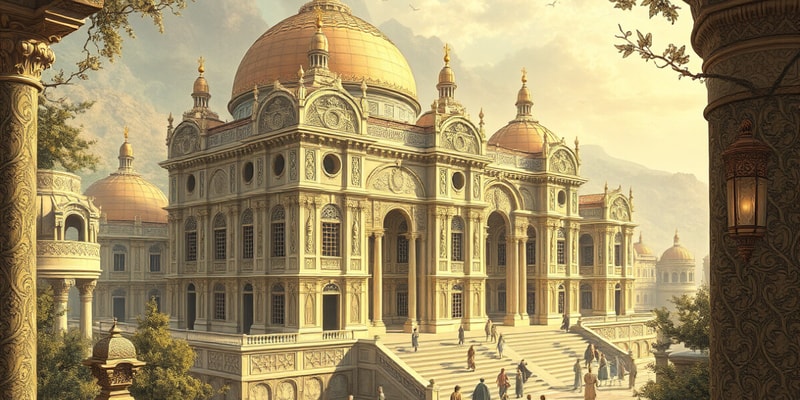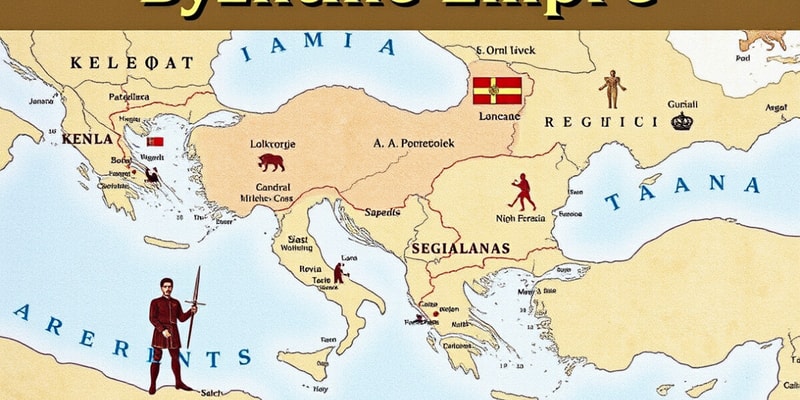Podcast
Questions and Answers
What was a significant factor contributing to the rise of the Ottoman Turks in relation to the Byzantine Empire?
What was a significant factor contributing to the rise of the Ottoman Turks in relation to the Byzantine Empire?
What did the Nika Riots of 532 reveal about the Byzantine Empire?
What did the Nika Riots of 532 reveal about the Byzantine Empire?
Which of the following best describes the outcome of the final defense led by Constantine XI?
Which of the following best describes the outcome of the final defense led by Constantine XI?
What was the cultural impact of the fall of Constantinople on Western civilization?
What was the cultural impact of the fall of Constantinople on Western civilization?
Signup and view all the answers
What were the themes of local revolts in the Byzantine Empire often driven by?
What were the themes of local revolts in the Byzantine Empire often driven by?
Signup and view all the answers
What was a key feature of the emperor's authority in the political structure?
What was a key feature of the emperor's authority in the political structure?
Signup and view all the answers
What was the role of the Church during the period when Christianity became the state religion?
What was the role of the Church during the period when Christianity became the state religion?
Signup and view all the answers
How did the theme system contribute to military strategy?
How did the theme system contribute to military strategy?
Signup and view all the answers
Which key figure established Constantinople as the new capital?
Which key figure established Constantinople as the new capital?
Signup and view all the answers
What was the outcome of the Battle of Manzikert in 1071?
What was the outcome of the Battle of Manzikert in 1071?
Signup and view all the answers
Which of the following accurately describes the impact of the Crusades on the Byzantine Empire?
Which of the following accurately describes the impact of the Crusades on the Byzantine Empire?
Signup and view all the answers
Which emperor is known for legal reforms known as Corpus Juris Civilis?
Which emperor is known for legal reforms known as Corpus Juris Civilis?
Signup and view all the answers
What strategy did the Byzantine Empire use alongside regular troops?
What strategy did the Byzantine Empire use alongside regular troops?
Signup and view all the answers
Study Notes
Political Structure
- Emperor's Authority: Centralized power; emperor held divine right and absolute authority.
- Bureaucracy: Complex administration; divided into various departments (e.g., finance, military).
- Provincial Administration: Regions governed by appointed officials; local autonomy was limited.
- Council Influence: Often consulted on important decisions; included high-ranking clergy and officials.
Religious Influences
- Christianity as State Religion: Became official under Emperor Theodosius I (379-395 CE).
- Role of the Church: Significant in governance; the Patriarch of Constantinople held considerable power.
- Iconoclasm Controversy: Divisions over the use of religious images; led to conflicts within the Church.
- Crusades: Initially seen as a way to reclaim the Holy Land; affected relations with the West.
Military Strategies
- Theme System: Provincial armies; local soldiers responsible for defending their regions.
- Fortifications: Strong defensive structures in cities, especially Constantinople, using advanced techniques.
- Mercenary Use: Reliance on mercenaries alongside regular troops for various campaigns.
- Naval Power: Emphasis on a strong navy to control maritime trade routes and protect against invasions.
Key Figures
- Constantine I: First Christian emperor; established Constantinople as the new capital.
- Justinian I: Known for legal reforms (Corpus Juris Civilis) and ambitious military campaigns.
- Heraclius: Reorganized the empire; introduced themes to improve military efficiency.
- Basil II: Expanded the empire; known as "Basil the Bulgar Slayer" for military successes against Bulgaria.
Wars with Turks
- Battle of Manzikert (1071): Key defeat against the Seljuk Turks; led to loss of Anatolia.
- Crusades Impact: The First Crusade initially helped by weakening Turkish control; later, the empire struggled to maintain its territory.
- Rise of Ottoman Turks: Gradual encroachment on Byzantine lands; culminated in the fall of Constantinople.
Rebellions
- Nika Riots (532): Major uprising against Justinian; highlighted socio-economic discontent.
- Themes Revolts: Local discontent often led to uprisings; sometimes driven by military leaders seeking power.
- Civil Wars: Internal strife during periods of weakened imperial authority; exacerbated by succession crises.
End of Empire
- Fall of Constantinople (1453): Marked the end of the Byzantine Empire; conquered by the Ottoman Empire.
- Constantinople's Significance: Economic and cultural center; its fall represented a shift in power.
- Cultural Legacy: Despite the fall, Byzantine culture influenced the Renaissance and Western civilization.
- Final Attempts at Defense: Last emperor, Constantine XI, led a valiant defense but ultimately succumbed to overwhelming forces.
Political Structure
- Centralized authority under the emperor, who possessed divine right and absolute power.
- A complex bureaucracy with various departments, including finance and military.
- Provincial administration controlled by appointed officials, limiting local autonomy.
- A council of high-ranking clergy and officials often consulted on critical state decisions.
Religious Influences
- Christianity became the official state religion during the reign of Emperor Theodosius I from 379 to 395 CE.
- The Church played a significant role in governance, with the Patriarch of Constantinople wielding substantial power.
- The Iconoclasm Controversy sparked divisions within the Church regarding the use of religious images.
- The Crusades were initially intended to reclaim the Holy Land, impacting relationships with Western nations.
Military Strategies
- The Theme System organized provincial armies, entrusting local soldiers to defend their regions.
- Advanced fortifications protected cities like Constantinople, showcasing superior construction techniques.
- The empire utilized mercenaries alongside regular troops to bolster military campaigns.
- A strong navy was prioritized to maintain control over maritime trade routes and defend against invasions.
Key Figures
- Constantine I: The first Christian emperor who founded Constantinople as the empire's new capital.
- Justinian I: Renowned for his legal reforms encapsulated in the Corpus Juris Civilis and ambitious military endeavors.
- Heraclius: Reformed the empire's structure and introduced the theme system for improved military efficiency.
- Basil II: Expanded the empire significantly, earning the nickname "Basil the Bulgar Slayer" for his military victories against Bulgaria.
Wars with Turks
- The Battle of Manzikert in 1071 marked a significant defeat against the Seljuk Turks, leading to the loss of Anatolia.
- The First Crusade initially weakened Turkish dominance, aiding the empire, but subsequent struggles ensued to maintain territory.
- The rise of the Ottoman Turks represented a gradual erosion of Byzantine lands, ultimately resulting in the fall of Constantinople.
Rebellions
- The Nika Riots of 532 were a major uprising against Justinian, highlighting widespread socio-economic discontent.
- Revolts within themes occurred frequently, often instigated by military leaders seeking to elevate their power.
- Civil wars erupted during times of reduced imperial authority, exacerbated by crises over succession.
End of Empire
- The Fall of Constantinople in 1453 signified the end of the Byzantine Empire, conquered by the Ottoman Empire.
- Constantinople was a vital economic and cultural hub; its fall marked a pivotal shift in geopolitical power.
- Despite its demise, Byzantine culture significantly influenced the Renaissance and Western civilization.
- Last emperor Constantine XI bravely defended the city but ultimately fell to overwhelming opposition forces.
Studying That Suits You
Use AI to generate personalized quizzes and flashcards to suit your learning preferences.
Description
Explore the intricate political and religious systems of the Byzantine Empire. This quiz covers the emperor's authority, the role of the church, and military strategies such as the theme system. Delve into the complexities of governance and the impact of Christianity as the state religion.




